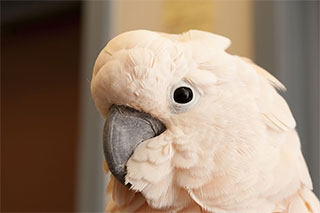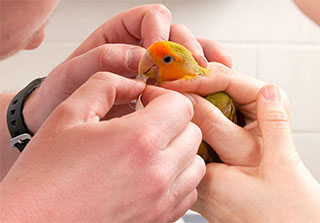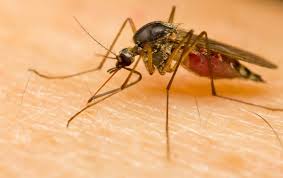Exotics Health
Here are some examples of our research and the impact it has on companion animal health

Controlling pain critical in medical treatment of companion birds
One of the main areas of clinical research for faculty members in the Companion Avian and Exotic Pet Service at the school involves the mechanisms of pain and pain management. Supported by the CCAH's competitive grants program, our researchers have conducted a number of studies with an end goal of developing better pain management for our patients.
In all species, controlling pain is critical for medical treatment. Our researchers are attempting to better understand the effectiveness, safety and potential side effects of pain medications for use in birds experiencing acute or chronic pain, or inflammation. Reducing inflammation can ease discomfort and reduce tissue damage, which aids in the healing process.
One recent study investigates how the pain medication fentanyl can reduce the amount of anesthetic drugs used in birds during procedures such as surgery. As thousands of avian species exist in the world, different species may respond differently to pain-relieving analgesics. Also, birds don’t necessarily respond in a way similar to mammals, says Dr. Michelle Hawkins, a professor in the Department of Medicine and Epidemiology.
The research team examined the use of a constant drip of fentanyl during anesthesia in the red-tailed hawk — kept as falconry hunting companions — and in Amazon parrots. “The hawks responded amazingly well and in a very similar way to mammals,” Hawkins says. The researchers showed that they could significantly reduce the use of inhalant anesthetics when fentanyl was administered intravenously, as well. The Amazon parrots also showed some reduction in inhalant anesthetics when fentanyl was used, but they needed more than 10 times the amount of fentanyl as the hawks. These findings underscore the importance of evaluating medications in the particular species of interest; not all birds are alike.
The team has a number of other projects focused on alleviating pain in birds, including a recent CCAH study to evaluate the use of an “extended release” analgesic in birds. If this drug proves to be effective, this could reduce the number of times a bird must be handled to administer the analgesic, minimizing patient stress and improving patient welfare.
Ultrasounds improve diagnosis of health issues affecting bearded dragons

Due to their gentle and social demeanor, bearded dragons are among the most popular reptile companion animals in their native Australia and in the Unites States, where they were introduced as pets in the 1990s. They’re curious creatures and like to explore. Their diet consists simply of insects and some vegetables. These lizards seem to enjoy interacting with people, and it’s only when they feel threatened or territorial that they’ll flare the skin under their chin to resemble a dragon.
Common health issues can plague bearded dragons, including nutritional disorders, gastrointestinal problems, parasites and obstructed labor (known as dystocia). Less common conditions include gastric cancer, liver cancer, kidney failure and viral infections. Veterinarians use ultrasound as a critical tool in the diagnosis of many of these conditions.
Ultrasound technology is noninvasive and produces better imaging than other techniques, such as radiography, which relies on X-rays. A few years ago, researchers at the UC Davis School of Veterinary Medicine noted that although abdominal ultrasonographic techniques and interpretation for dogs and cats were well described, only a few reports described the use of ultrasonography in reptiles. This significant finding highlighted the major anatomic differences between mammals and most reptiles, and the substantial variability within reptile species.
In 2013, school researchers set out to expand on the body of knowledge about the use of ultrasound in improving the health of bearded dragons. Using a grant from the CCAH, the team conducted a study of ultrasound anatomy on 14 healthy bearded dragons — six females and eight males, all between 6 and 11 months of age. Their objective was to determine which organs can be reliably visualized through ultrasound, describe their normal appearance and describe an ultrasound technique for use with bearded dragons. The findings were published in an April 2015 edition of the Journal of the American Veterinary Medical Association.
Their study indicated that using ultrasounds on the coelom — the main body cavity— is a valuable imaging tool for assessing most organs in bearded dragons, and can be performed in animals that aren’t sedated. “Ultrasound gives much greater imaging detail and allows us to evaluate organs such as the liver, spleen, gastrointestinal tract and reproductive tract,” says Dr. Allison Zwingenberger, the faculty principal investigator on the project. “The technique and description of findings in normal animals helps us to detect abnormalities in sick animals.”
Dr. Daniel Bucy, a resident in Small Animal Imaging, led the project supported by the CCAH, which was one of 14 grants awarded for resident research in 2013 — totaling about $55,000 — for projects that benefit dogs, cats and small exotic pets. Dr. David Sanchez-Migallon Guzman provided specialist knowledge on the anatomy and physiology of bearded dragons. As the school’s team continues to study bearded dragons, they will be gathering information on the ultrasound appearance of lesions that will help to direct future research in this area.
- TOP -
Researchers undertake critical studies on antibiotics in exotics

Having a rabbit as a pet can bring boundless joy. Their intelligence and social demeanor, plus their strong personalities, make them desirable animal companions; however, rabbits are prey animals in the wild and so they mask signs of disease much longer than other pets. When they get sick, it’s absolutely necessary that a pet owner consult with a veterinarian before giving a rabbit any medication, especially antibiotics, as many human drugs are toxic to these furry friends.
Rabbits are among the most common small mammals brought to veterinary clinics, shelters and wildlife centers, which means veterinarians need to know which antibiotics work most effectively, and ensure the drugs are administered in a way that causes as little stress as possible. Due to the rabbit’s unique and sensitive gastrointestinal system, many oral antibiotics commonly given to other species cannot be used safely in these animals.
Dr. Sara Gardhouse, a resident in the school’s Companion Exotic Animal Medicine and Surgery Service, is leading a research project on the effects of long-acting crystalline-free acid antibiotics (CCFA) on New Zealand white rabbits. She and her colleagues are collecting blood samples from rabbits that have been administered this antibiotic, and measuring the antibiotic present in their blood to determine whether the doses are safe and the concentrations effective at killing bacteria. The team also aims to determine how long this drug is effective. “This will result in improved health of sick rabbits, decreased stress and pain from repeated handling and injections, and improved well-being of these animals,” according to Gardhouse. She received funding from the CCAH’s Resident Grants Program to undertake this research.
Setting the stage for the New Zealand white rabbit project was a pilot study on the effects of CCFA in red-tailed hawks. This study — also funded by the CCAH — evaluated the beneficial and adverse side effects of a single dose of CCFA in red-tailed hawks. This species of raptor is very common in the United States, and are kept as falconry hunting companions, as well as being one of the most common wild bird species presented to rehabilitation facilities. These hawks are also at risk for bacterial infections, prompting the need for antibiotics that can be given infrequently — administering an antibiotic to a sick raptor requires physically restraining the bird, causing significant distress.
In an article in the December 2015 issue of the American Journal of Veterinary Research, the team published their dosing recommendations for a long-acting antibiotic in red-tailed hawks. They found the dose of CCFA effective for between 3 to 5 days, based on susceptible bacteria. “That is amazing, because all of the animals we work with are stressed very easily, so our goal is to provide therapy with minimal stress,” says Dr. Michelle Hawkins, chief of the Companion Exotic Animal Medicine and Surgery Service and director of the California Raptor Center at UC Davis. That means veterinarians can administer the antibiotic every few days, as opposed to every few hours substantially minimizing the stress of handling for therapy.
- TOP -
Chronic egg-laying can become health emergency

Egg-laying is extremely taxing. If left unchecked, chronic egg-laying can lead to hypocalcemia (calcium deficiency) and dystocia, which means difficult or abnormal birth. “Chronically laying eggs takes a lot of energy and calcium and creates significant health problems that can become an emergency,” says Dr. Michelle Hawkins, a professor in the school’s Department of Medicine and Epidemiology.
This alarming reproductive disease is a problem in many bird species, but especially cockatiels and lovebirds — two popular types of companion parrots. UC Davis researchers have conducted groundbreaking studies, supported in part by the CCAH, to address this issue, by examining the effects of a hormone implant (similar to a microchip) in shutting down egg-laying.
One recent study evaluated the effects of 4.7-milligrams of a hormone implant (called deslorelin acetate) on egg laying in healthy cockatiels. Researchers found that the implants significantly increased the latency of egg laying compared to placebo implants in cockatiels — 11 out of 13 placebo-implanted birds laid eggs between 12 and 42 days following implantation. On the other hand, none of the hormone-implanted birds laid eggs within the first six months of the study, and only five out of 13 implanted birds laid their first egg between 192 and 230 days following implant placement, says Dr. David Guzman, an associate professor in the Department of Medicine and Epidemiology, who served as the faculty principal investigator.
The cockatiel project builds off a previous CCAH-funded study, published in December 2015 in the Journal of Zoo and Wildlife Medicine, in which researchers compared implants with two different concentrations of the hormone on egg production in Japanese quail. Those findings also indicated that the administration of 4.7-milligram hormone implants was effective in ceasing egg laying among the birds. The team will conduct further research to figure out how to inhibit egg laying to ensure the best health of birds.
- TOP -
 What is the West Nile virus?
What is the West Nile virus?
The West Nile virus is a strain of encephalitis disease, genetically similar to St. Louis encephalitis, that can affect the central nervous system. WN virus causes a swelling of the brain that, though treatable, can be fatal in a small portion of infected people and animals. The virus can be carried by birds and transmitted by mosquitoes that feed on an infected bird and then feed on a human or animal.
Among wild birds, Corvids such as crows, scrub jays and magpies are particularly susceptible. Indeed, WN virus has had a significant impact on these and other bird species. Pet birds are probably at greater risk to WN virus than dogs or cats. Owners of pet birds should refer to the CDC website table of bird deaths from WN virus between 1999 and 2007. Pet species are usually classified as exotic in this table. (http://www.cdc.gov/ncidod/dvbid/westnile/)
Can small companion animals such as birds, cats and dogs contract WN virus?
Dogs and cats are susceptible to infection, but considerably more resistant to disease than horses, humans, and some species of birds. Very young and very old cats and dogs, and animals that are immunocompromised for some other reason, are the most likely to show signs of illness. Signs of a possible infection include weakness, fever and muscle spasms, although blood tests are needed to confirm a diagnosis. Treatment is consistent with standard veterinary practices for viral infections, and recovery is likely. If you suspect that your animal may be infected, seek the advice of your regular veterinarian.
How likely is it that my cat or dog will catch WN virus?
It is very unlikely for healthy dogs or cats to become ill with this virus. Pet owners should do the same things that they should do to protect themselves and family members: eliminate mosquito habitat and avoid mosquito exposure. Private veterinarians may also be consulted for recommendations on safe, effective mosquito repellents that may be used on pets. DEET-containing products are not approved for pets and should not be used. It is very important not to use human insect repellent on your animal as it may cause poisoning.
Can I contract the virus from my infected animal?
West Nile virus infection has been confirmed in some domestic animals, including pet birds, dogs and cats. However, there is no evidence that a person can get the virus from handling any animal, including live or dead infected birds. Furthermore, there is no evidence that West Nile virus can be transmitted to humans through consuming infected birds or animals.
There is no evidence that a person can get WN virus from handling live or dead infected birds. However, one should always use caution when handling dead birds. Persons should avoid bare-handed contact when handling any dead animals, and use gloves or double plastic bags to place the bird carcass in a garbage bag or contact their local health department for guidance.
Can the virus be transmitted from animal to animal?
It is possible that dogs and cats could become infected by eating dead infected animals such as birds, but this is undocumented. Veterinarians should take normal infection control precautions when caring for an animal suspected to have this or any viral infection.
How common is WN virus in California?
For information on WN virus in California please visit the California Vectorbourne Disease Surveillance Center's website http://westnile.ca.gov/. This site contains the most current information on the spread of WN virus in California.
What can I do to protect myself as well as my companion animals?
WN virus is transmitted by infectious mosquitoes. Dogs or cats could be exposed to the virus in the same way humans become infected. To protect your self as well as your animals these precautions are recommended:
- Make sure that doors and windows have tight-fitting screens. Repair or replace all screens that have tears or holes.
- Eliminate mosquito breeding sites from around your home (standing water).
- Don't go outside in the early evening or at dawn.
- If you are outdoors during those times, wear long-sleeved shirts and long pants. But bear in mind that mosquitoes can bite through thin cloth.
- Consider using insect repellent (the CDC recommends using one with permethrin or DEET) on your skin and clothing, particularly if you live in a wet, low-lying area where mosquitoes might breed. But use insect sprays sparingly and cautiously. (This means never spraying repellents on children under the age of three or on the hands of children who might put them in their mouths.) DEET-containing products are not approved for pets and should not be used. It is very important not to use human insect repellent on your animal as it may cause poisoning.
- Dispose of any unused outside water containers and drill holes in the bottom of containers that are left outdoors. Turn over plastic wading pools or wheelbarrows when not in use, and do not allow water to stagnate in birdbaths.
- Clean clogged roof gutters regularly.
- Ventilate ornamental pools or stock them with fish.
- Clean and chlorinate swimming pools that are not in use.
- If you have livestock, thoroughly clean their troughs every month.
- Don't rely on ultrasonic mosquito-repelling machines or vitamin B to ward off bites.
- TOP -
